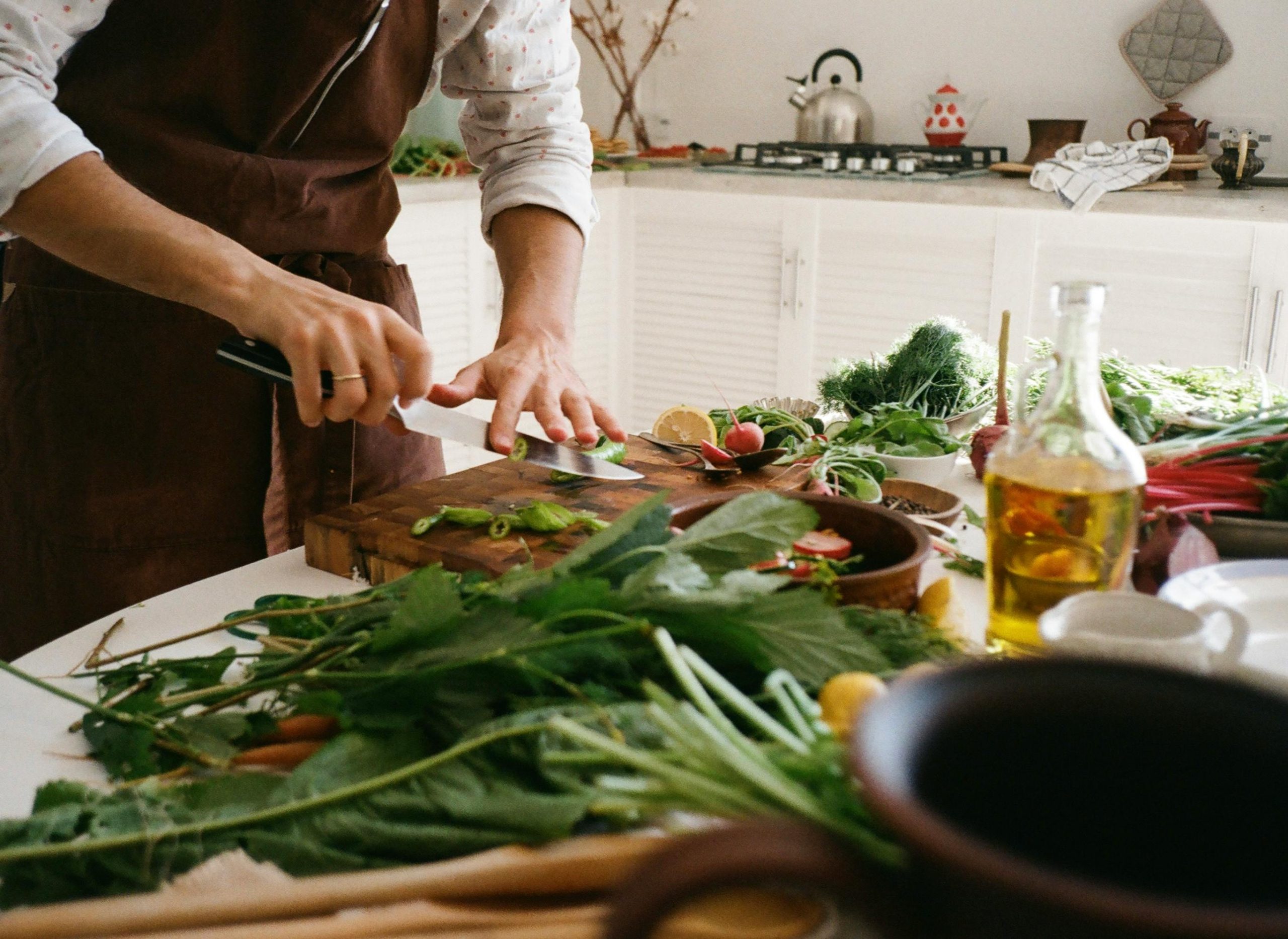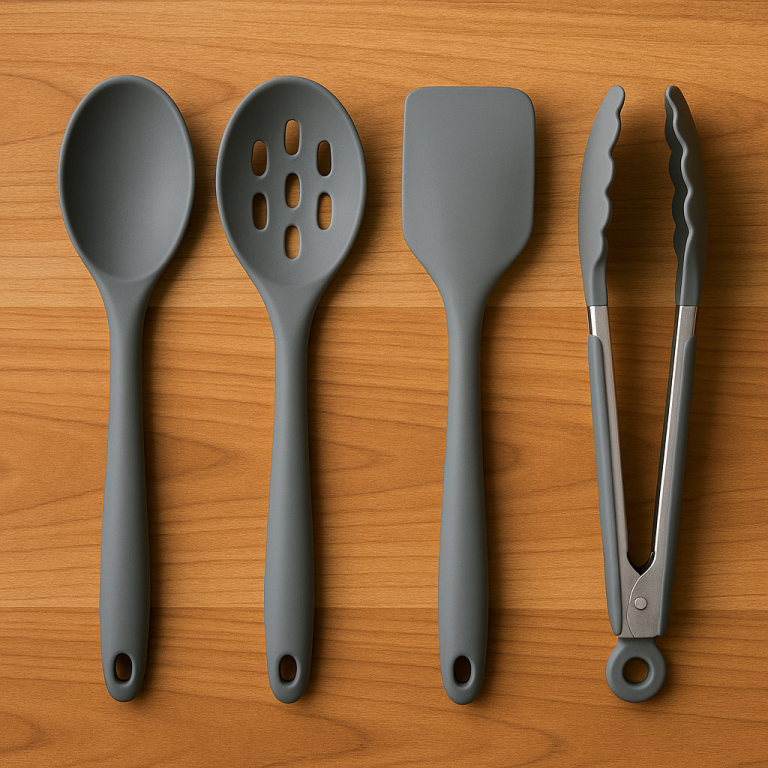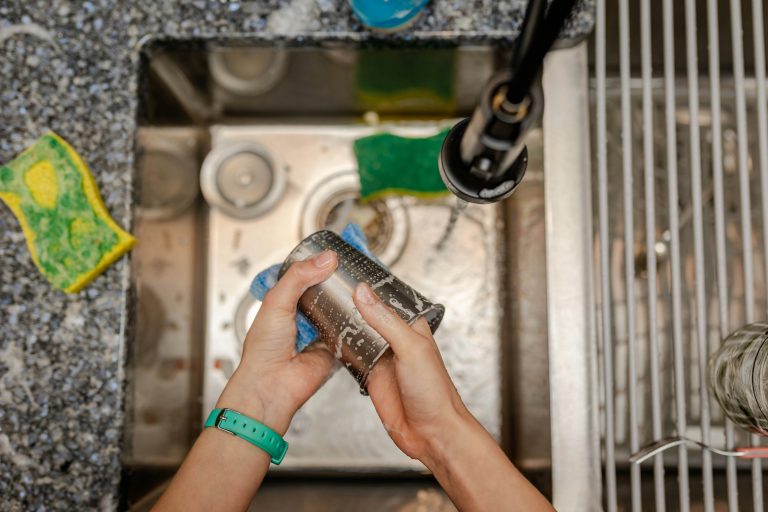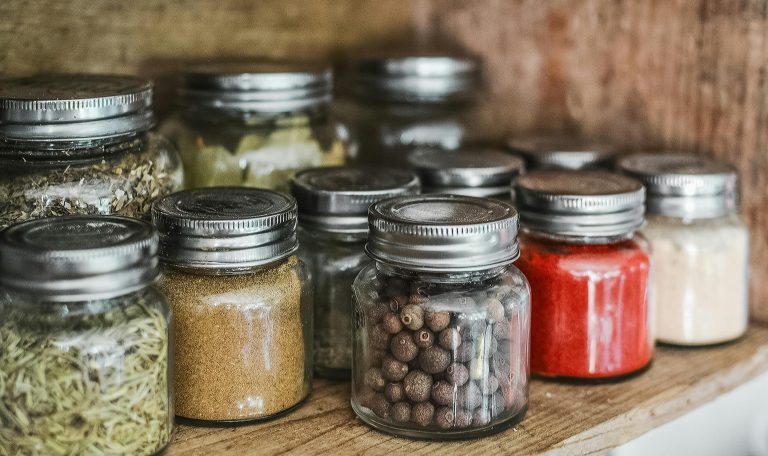The Best Wooden Cutting Boards You Should Be Using In Your Kitchen
At a Glance: Our Top Pick Roundup:
- Overall Top Pick: John Boos R-Board Series
- Best Budget Pick: Yes4All Durable Acacia Cutting Board
- Our Favorite Middle of the Line Board: Ironwood Gourmet Large End Grain Prep Station
- A Solid Butcher Block Cutting Board: Made In Cookware – Butcher Block – Maple Wood
- The Premium Option: Boardsmith Maple End Grain Cutting Board
Why Use a Wood Cutting Board Over Plastic
When it comes to choosing between wood and plastic cutting boards, you might be tempted to grab the plastic one for its apparent ease. But let’s consider why wood might be the better choice for your kitchen.
- Wood is gentler on your knives. A wood surface gives slightly, helping to preserve your knife’s sharp edge for longer. Plastic, on the other hand, can dull your knives more quickly.
- Wood possesses natural antibacterial properties. Certain types of wood can actually inhibit bacterial growth, making them a surprisingly hygienic option. Board maintenance is still important, though!
- Wood cutting boards are often more durable. With proper care, a good wooden board can last for years, even decades. Plastic boards, especially those that get heavily scratched, should be replaced more frequently.
- Most importantly, wooden cutting Boards don’t release uncountable microplastics into your meal and the environment like plastic boards do.
Here’s a quick comparison:
| Feature | Wood | Plastic |
|---|---|---|
| Knife Friendliness | Better | Worse |
| Durability | High (with proper care) | Lower (requires more frequent replacement) |
| Maintenance | Requires oiling and hand washing | Dishwasher safe |
| Antibacterial | Natural properties | None |
| Environmental | Sustainable options available | Contributes to plastic waste |
While plastic boards have their place, often a popular choice for raw meats, a good wooden cutting board is an investment in your kitchen that offers both performance and longevity.
Overall Top Pick: John Boos R-Board Series
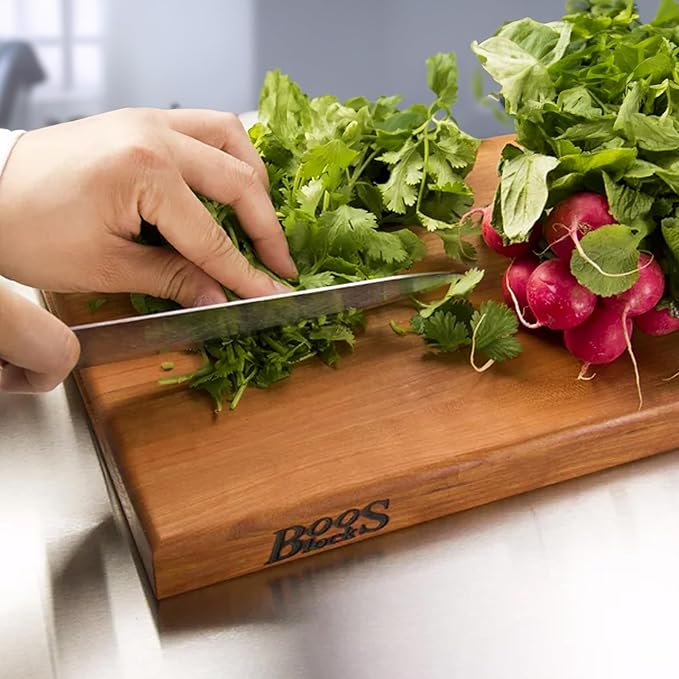
For our overall top pick, we’ve selected the John Boos R-Board Series. This board offers a fantastic balance of quality, durability, and price, making it a great choice for most home cooks.
This board comes in three wood options: cherry, maple, and walnut. You’ll find that it’s thick enough to handle heavy-duty chopping, but not so bulky that it’s difficult to move around. Plus, it’s reversible, giving you two usable surfaces and extending the board’s lifespan. This is a great durable, thick wooden cutting board for any kitchen.
Here are a few reasons why we think the John Boos R-Board Series stands out:
- Durability: Made from high-quality wood, this board is built to last.
- Knife-Friendly: The wood is gentle on your knives, helping to keep them sharp.
- Reversible Design: Two usable surfaces for extended lifespan.
- Easy to Clean: Simple to wipe down and maintain.
While it might be a bit pricier than some other options, the John Boos R-Board Series is a worthwhile investment for anyone who spends a lot of time in the kitchen. You’ll appreciate the quality and durability of this board for years to come. You can even use it to prepare a Thanksgiving Turkey.
Best Budget Pick: Yes4All Durable Acacia Cutting Board
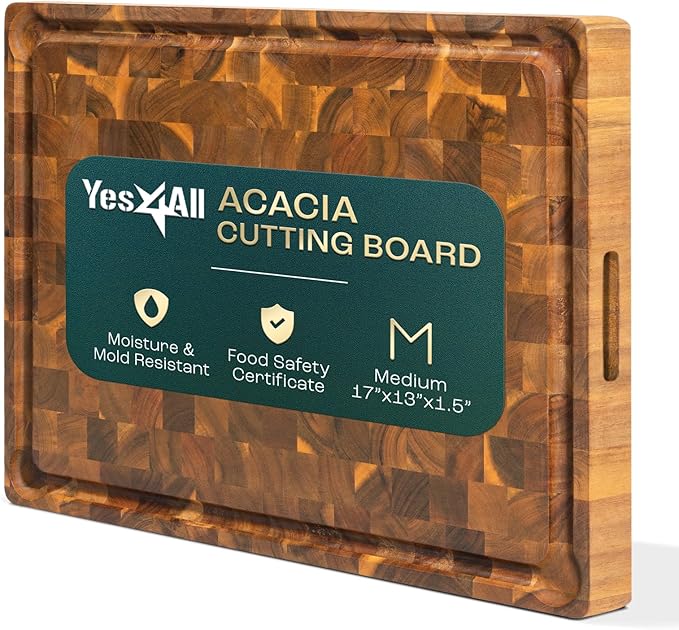
Looking for a solid wood cutting board that won’t break the bank? The Yes4All Durable Acacia Cutting Board is a great option if you’re on a budget. You can usually find it for under $50, which is a steal for a solid wood board.
It’s surprisingly spacious, giving you plenty of room to work, and it’s got a nice heft to it, so it won’t slide around on your countertop while you’re chopping. Plus, it’s made of acacia wood, which is fairly durable.
Here’s a quick rundown:
- Affordable price point
- Good size for everyday tasks
- Durable acacia wood construction
Our Favorite Middle of the Line Board: Ironwood Gourmet Large End Grain Prep Station
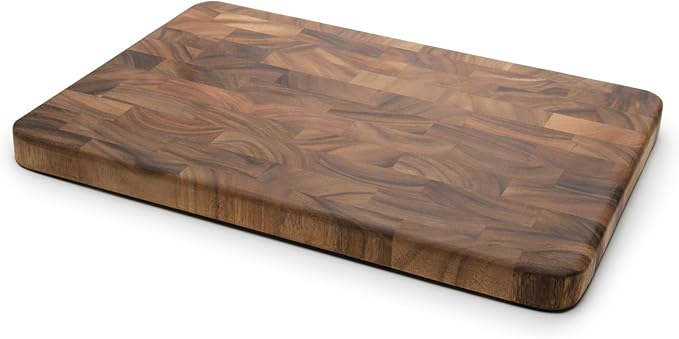
Okay, so you’re looking for something that’s a step up from the budget options but doesn’t quite break the bank? The Ironwood Gourmet Large End Grain Prep Station might be just what you need. It’s that sweet spot where quality meets affordability, making it a solid choice for most home cooks.
This board is made from acacia wood, which is known for its durability and resistance to water damage. That’s a big plus if you’re like me and sometimes forget to wipe down the board immediately after use. It’s also got a nice weight to it, so it won’t slide around on your countertop while you’re chopping away. I find that super annoying with lighter boards.
The end-grain construction is another key feature. This means the wood fibers are oriented vertically, which is gentler on your knives and helps the board resist scratches and gouges. Plus, it looks pretty darn good, adding a touch of rustic charm to your kitchen.
It’s not perfect, of course. The finish might not be as refined as some of the higher-end boards, and you might find a small imperfection here or there. But for the price, it’s hard to complain. It’s a workhorse that can handle most of your daily chopping and slicing needs.
Here’s a quick rundown:
- Durable acacia wood construction
- End-grain design is knife-friendly
- Good size for everyday use
- Affordable price point
A Solid Butcher Block Cutting Board: Made In Cookware – Butcher Block – Maple Wood
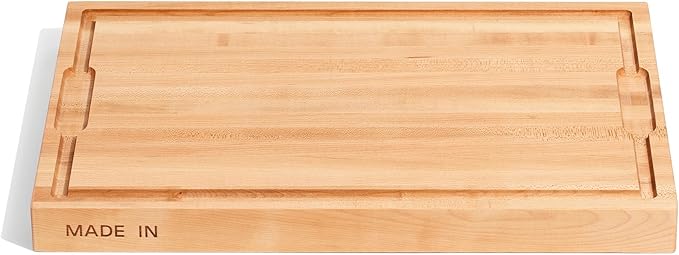
If you’re looking for a reliable, no-nonsense butcher block, the Made In Cookware Maple Butcher Block is a great option. It’s not the flashiest, but it gets the job done, and it does it well. This board is crafted from maple wood, known for its durability and resistance to knife marks. You’ll find it’s a solid, stable surface for all your chopping needs.
Here’s what you can expect:
- Sturdy Construction: This board is built to last. The maple wood is dense and provides a stable cutting surface.
- Good Size: It offers ample space for prepping ingredients without being too unwieldy.
- Easy to Clean: While hand-washing is recommended, it’s relatively easy to keep clean with proper care.
One thing to keep in mind is that, like all wooden cutting boards, it requires regular oiling to prevent drying and cracking. A little maintenance goes a long way in extending its lifespan.
While it might not have the fancy features of some other boards, its simplicity and solid construction make it a dependable choice for any kitchen. It’s a workhorse that will stand up to daily use.
The Premium Option: Boardsmith Maple End Grain Cutting Board
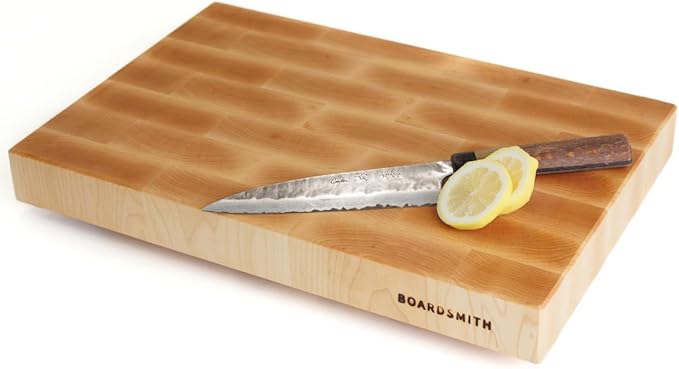
If you’re looking to invest in a truly top-tier cutting board, the Boardsmith Maple End Grain Cutting Board is a fantastic choice. Handmade in Texas from sustainably harvested, premium-grade domestic maple, this board is built to last. You’ll immediately notice the quality craftsmanship.
The Boardsmith board is thicker than many others on the market, which some cooks might find preferable. This added height can make chopping a bit more comfortable. The exposed wood ends also have a really nice, eye-catching arrangement. It just looks great in your kitchen.
One of the things that sets this board apart is the option to add custom features. Want a juice groove on the underside? No problem. Need finger grooves for easier handling? They’ve got you covered. These options do come at an extra cost, but they allow you to create a board that’s perfectly tailored to your needs.
Here’s a quick rundown:
- Handmade in the USA
- Made from sustainably harvested maple
- Customizable with juice grooves and engravings
Features We Care About
When you’re picking out a wooden cutting board, it’s easy to get lost in all the options. But don’t worry, we’ve narrowed down the most important things to consider so you can find the perfect board for your kitchen. It’s not just about looks; it’s about how the board performs and how well it holds up over time.
Size and Weight
Size matters, especially when it comes to cutting boards. You need enough surface area to prep your ingredients comfortably. A tiny board might be cute, but it’s not practical for chopping a whole chicken or dicing a bunch of vegetables. Think about the types of meals you usually make and how much space you typically need.
- Small (Under 12×16 inches): Great for small kitchens or quick tasks like slicing a lemon. Easy to store and clean.
- Medium (12×16 to 16×20 inches): A good all-around size for most home cooks. Offers enough space for prepping most meals without being too bulky.
- Large (Over 16×20 inches): Ideal for serious cooks or those who frequently entertain. Provides ample space for large cuts of meat or prepping multiple ingredients at once.
Weight is another factor. A lighter board is easier to move around and clean, but a heavier board tends to stay put while you’re chopping. It really comes down to personal preference and how much counter space you have. If you have limited space, you might want to consider a lighter board that you can easily store away. If you have plenty of counter space and prefer a stable surface, a heavier board might be the way to go. A durable maple wood cutting board is a great option.
Consider where you’ll be storing the board. A large, heavy board might be difficult to lift in and out of a high cabinet. A smaller, lighter board can be easily tucked away in a drawer or on a shelf.
Type of Wood
When you’re picking out a wood cutting board, the type of wood matters a lot. It affects how the board feels to cut on, how well it holds up, and even how it looks in your kitchen. Different woods have different properties, so it’s worth understanding the basics before you buy.
- Maple: This is a popular choice, and for good reason. Maple is hard enough to take a beating but still gentle on your knives. It’s also a pretty common wood in the US, which helps keep the price reasonable. Plus, maple has a closed-pore structure, making it a great material for cutting boards because it’s less likely to absorb liquids and bacteria.
- Walnut: Walnut is a beautiful, dark wood that adds a touch of elegance to your kitchen. It’s a bit softer than maple, so it might show scratches more easily, but many people love its rich color. Walnut also has natural oils that can help it resist moisture.
- Cherry: Cherry wood is another attractive option with a reddish hue. It’s harder than walnut but softer than maple. Like walnut, cherry can darken over time, adding character to your board.
- Acacia: Acacia is a durable and water-resistant hardwood that’s becoming increasingly popular for cutting boards. It’s naturally antibacterial and has a striking, varied grain that ranges from light golden to deep brown, giving each board a unique look. While slightly harder than maple, it still won’t dull your knives quickly, and it holds up well to daily use.
Board Maintenance
Okay, so you’ve got your awesome new wooden cutting board. Now what? It’s not like those plastic ones you can just toss in the dishwasher. Wood needs a little love to keep it in tip-top shape and prevent it from drying out, cracking, or becoming a breeding ground for unwanted guests.
First things first: hand-washing is your best friend. After each use, give your board a good scrub with warm, soapy water. Don’t let it soak, though! That’s a big no-no. Get it clean, rinse it well, and then dry it immediately with a clean towel. Seriously, don’t just leave it sitting there to air dry. That can lead to warping.
Now, for the fun part: oiling. Think of it like moisturizing your skin, but for wood. You’ll want to use a food-grade mineral oil or a board butter (a mix of mineral oil and beeswax). About once a month (or more often if your board is looking dry), apply a generous amount of oil to the entire surface of the board. Let it sit for a few hours, or even overnight, so the wood can really soak it up. Then, wipe off any excess oil with a clean cloth. This keeps the wood hydrated and prevents it from cracking.
Taking care of your wooden cutting board might seem like a pain, but it’s really not that bad. A little bit of effort will go a long way in extending the life of your board and keeping it looking beautiful for years to come. Plus, a well-maintained board is just more enjoyable to use.
Here’s a quick rundown:
- Wash by hand with warm, soapy water after each use.
- Dry immediately with a clean towel.
- Oil regularly with food-grade mineral oil or board butter.
- Avoid soaking the board in water.
- Store the board in a dry place.
A Quick Note On Bamboo Cutting Boards
While bamboo might seem like a great, eco-friendly option for a cutting board, there are a few reasons why you might want to reconsider.
First off, bamboo is harder than many types of wood typically used for cutting boards. This can actually be quite tough on your knives. Over time, using a bamboo board can dull your knife blades faster than softer wood options. You’ll find yourself sharpening them more often, which is a hassle.
Another thing to consider is that bamboo, while technically a grass, isn’t as naturally antibacterial as some hardwoods. While all cutting boards need to be cleaned thoroughly, you might need to be extra diligent with a bamboo board to prevent bacteria buildup.
Some cheaper bamboo boards are made with glues that aren’t food-safe, so you’ll want to do your research and make sure you’re buying from a reputable brand.
Finally, bamboo boards can be more prone to cracking and splintering than other wood boards if they aren’t properly cared for. They need regular oiling to prevent them from drying out and becoming damaged. It’s just another step in maintenance that you might not want to deal with.
End Grain Cutting Boards – Why Many People Like to Use them
An end grain cutting board is constructed differently than your standard cutting board, and this difference is why many cooks swear by them. Instead of the wood grain running horizontally, like in edge-grain boards, the end grain is oriented vertically – think of the rings you see on a tree stump. This orientation offers some distinct advantages.
One of the biggest benefits is that they’re easier on your knives. When you cut on an end grain board, the knife blade slips between the wood fibers, rather than cutting across them. It’s like cutting into the ends of a bunch of straws; the fibers give way and then close back up after the knife passes. This helps to preserve the sharpness of your knives for longer.
Another advantage is that end grain boards tend to be more durable. Because the wood fibers absorb the impact of the knife, the board is less likely to show scratches and gouges. This also means they can “self-heal” to some extent, as the fibers can close back up after being cut. This self-healing property helps prevent bacteria from getting trapped in deep grooves, making the board more hygienic.
Picking Your Perfect Board
So, there you have it. Choosing a wooden cutting board isn’t just about looks; it’s about finding something that fits how you cook and what you cook. Think about the size you need, the kind of wood, and how much care you’re willing to put in. A good wooden board can last for ages if you treat it right. It’s an investment, sure, but one that makes your kitchen work a lot smoother. You’ll be glad you took the time to pick the right one, trust me.
Frequently Asked Questions
How do you clean a wooden cutting board?
Cleaning your wooden cutting board is simple! Just use a sponge, some dish soap, and a little effort. After washing, make sure to dry it really well and then stand it up so air can get to all sides. Never put your wooden board in the dishwasher. The high heat can twist and ruin the wood, and it will get too wet.
What kind of oil should you use for a wooden cutting board?
Food-safe mineral oil is a great choice. You can also find special balms, waxes, and ‘butters’ made just for wooden boards. Oiling your board regularly stops it from getting dry, helps seal up small cuts, and keeps stains and smells from soaking into the wood.
Are wooden cutting boards safe to use?
Yes, wooden cutting boards are safe, as long as you clean and dry them correctly. If you’re worried about germs spreading, it’s a good idea to have a few different boards. You can set one or two aside just for cutting raw meats.
Is acacia wood good for cutting boards?
Acacia wood is a good choice for cutting boards. It’s known for being strong and lasting a long time. It also looks nice, which is a bonus for your kitchen.
How often should you oil your wooden cutting board?
You should oil your wooden cutting board regularly, especially when it’s new or if it looks dry. A good rule of thumb is to oil it once a month, or more often if you use it a lot. This helps keep the wood healthy and looking good.
What should you do if your wooden cutting board smells bad?
If your wooden cutting board starts to smell, you can try cleaning it with a mix of baking soda and water, or rub half a lemon over the surface. Let it sit for a few minutes, then rinse and dry it well. This can help get rid of unwanted odors.

